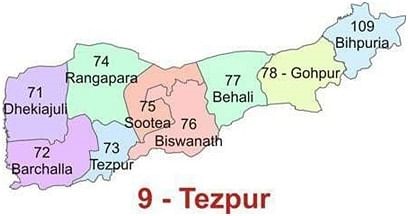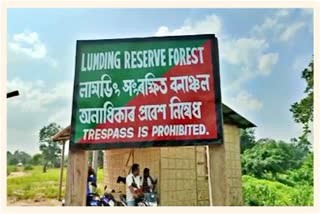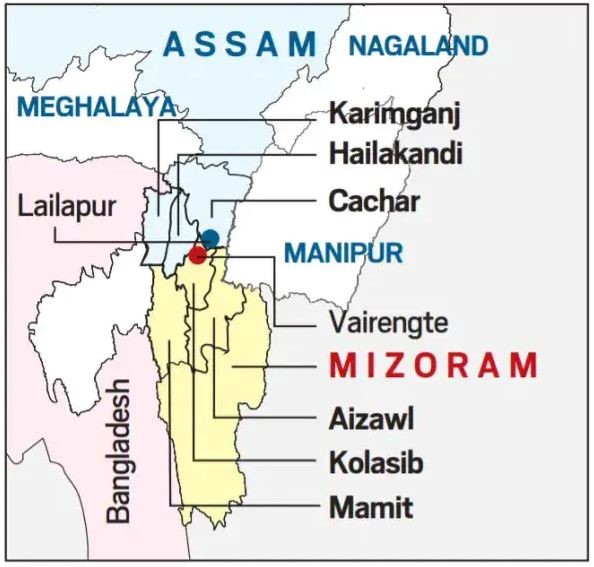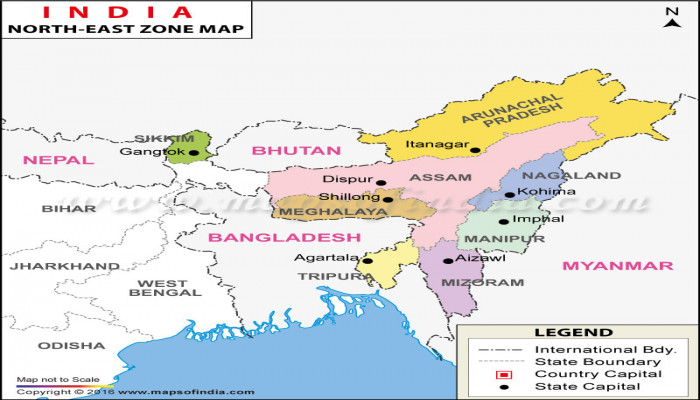The Politics of Land Encroachment: Assam & the North-East
- In Current Affairs
- 11:41 AM, Feb 01, 2022
- Ankita Dutta
The eviction drive undertaken by the Government of Assam at Gorukhuti village under Sipajhar Revenue Circle in Darrang district of Lower Assam in the month of September, 2021 against encroachers of dubious nationality had caught international news headlines from Pakistan’s Dawn to Al Jazeera TV. It was claimed that the State Government is targeting landless people belonging to a particular “minority” community. Their excellent networking capabilities to make their voices heard could be gauged from the fact that within just a few days after this eviction drive, various Islamic organisations, including Maulana Badruddin Ajmal’s All India United Democratic Front (AIUDF), staged a dharna in New Delhi against the “targeting of landless minorities in the name of eviction”.
Immediately after this incident, a certain section of the media, so-called human rights activists and propagandists disguised as “intellectuals”, left no stone unturned to tarnish the image of not just Assam CM Dr. Himanta Biswa Sarma but also the common people of Assam by labelling them as “xenophobics” and “Islamophobics”. These are pejorative terms that have been used and abused time and again to downplay a genuine sense of fear and insecurity that today haunts the common public sentiment in Assam over the future of their lands, language, culture and civilisation. The Bengali-speaking Muslim migrant community residing in Assam wants to maintain and strengthen its separate Miya identity – the demand for the recognition of a separate genre of Miya poetry and a Miya museum, celebrating the lives and cultures of the Muslims residing in the char-chapori areas.
Doesn’t the assertion and adaptation of this particular moniker called Miya by this community of immigrant Muslims stands in perfect line with the Do Qaumi Nazariya espoused and propagated by the Muslim League and Muhammad Ali Jinnah in 20th century British India? Well, we all know what happened eventually. By vouching for a separate micro-identity within the larger Assamese regional identity, there is an implicit support for the creation of another separate nation within the Indian nation. It is because a separate branch of Miya poetry or Miya language contains within itself the seeds of separate nationhood that proudly disowns India and an Indian identity.
Politically speaking, this community of Bengali-speaking Muslims in Assam has been keen to maintain its distinct Miya identity since the formation of the Muslim League in the year 1906, having elected an MLA Maulana Bhasani to the Assembly way back in 1937. Bhasani headed the Muslim League in its Barpeta session in the year 1940. The Muslim population of Assam today stands at 34% of the total population, increasing from 12.4% in 1901 when predominantly Muslim Sylhet was a part of Assam. Political power in several districts of Lower Assam bordering Bangladesh has already been lost to the immigrant Muslims. It is in this context that CM Dr. Himanta Biswa Sarma has repeatedly said that Assam is fighting a civilisational battle of survival in the midst of several enemies.
Dr. Sarma’s smart political strategies have ensured that the appeasement which they enjoyed during the Congress era comes to an end, with their role in governance being limited to only their areas of influence. Besides the relentless fight against drugs and drug mafias, continuous eviction drives to free all lands in Assam from encroachers have become a regular affair under his dispensation. Growing encroachment on Assam’s territory has, over the years, made the state part with vast tracts of forested lands, with successive state Governments very conveniently choosing to look the other way. It has now become the need of the hour to accord enhanced protection across those areas in Assam bordering Bangladesh, especially the forested areas.
This will serve the twin purpose of securing our borderland as also protecting our invaluable forest wealth. It is an open secret that these areas lack a proper security mechanism in the form of adequate manpower, forest camps, patrolling, jungle roads, etc. This has precisely been the reason for emboldening the neighbouring country and its people to prey upon Assam’s lands and accord legitimacy to their claims. Recently, the jurisdiction of the Border Security Force (BSF) was increased up to 50 km from the international border, which is expected to provide a major boost to border management; but, at the same time, the border guarding force will have to maintain a close coordination with the police forces of the states concerned.
In other words, the success of the new rules would depend, to a large extent, on proper coordination between the BSF and the state police forces. In the past, the police had managed to apprehend a number of infiltrators and cattle smugglers with inputs provided by the BSF. It may be recalled here that the BSF has been entrusted with the responsibility of guarding the international borders with Bangladesh and Pakistan (barring the LoC) covering 10 states and 2 Union Territories. In case of the border with Bangladesh in the east, the BSF personnel are permitted to use lethal weapons only as a measure of self-defence. This has been done primarily with a view to maintaining India’s cordial relations with Bangladesh.
The help and cooperation extended by the Government of Bangladesh under the leadership of Sheikh Hasina to tackle insurgency in the North-East is praiseworthy. Bangladesh has also agreed to allow India the use of Chittagong and Mongla ports that will open up the sea routes connecting the landlocked North-Eastern region. Although the BSF functions under different Acts and Rules, the extension of the jurisdiction has been done only in case of three Acts – Code of Criminal Procedure (CrPC), Passport Act, and Passport (Entry into India) Act. Earlier, the jurisdiction of the BSF was only upto 15 km from the international border.
Increasing the jurisdiction of the BSF is expected to act as a major boost in the task of border guarding. Under the existing rules, if an infiltrator or a criminal managed to sneak past BSF personnel deployed along the border, there was very little that the force could do. But, under the new rules, the BSF personnel would be able to chase an infiltrator, smuggler or criminal up to 50 km from the international border and also carry out raids in villages near the border, if required. Whenever the BSF apprehends a criminal or an infiltrator, he or she should be handed over to the nearest police station within 24 hours.
Efforts are also on to improve the quality of the border police organisation so that the process of detection and deportation of foreigners can be expedited. Deportation of Bangladeshi nationals apprehended in Assam and elsewhere in the country is a major problem and the Government of India is fully aware of the situation. Assam CM Dr. Himanta Biswa Sarma had once said that the Government of Bangladesh accepts the persons sought to be deported only when India can provide good evidence of their citizenship.
That is why, the State Government of Assam is trying to improve the quality of the border police organisation so that fool proof dossiers on the persons sought to be deported can be prepared. Only then the Bangladesh Government would be forced to accept such people as citizens of that country. The problem is huge and multifaceted. Increasing manpower in the police force is simply not enough; steps must be taken to improve the quality of work of all the personnel of our security forces. But what we need to accept here is that engineering a complete exodus of the migrant Muslims from Assam has now almost become close to impossible.
They still continue to be the bulk of the workforce tilling the fields, working in the buildings, roads and factories, tending cattle, driving buses, rickshaws and thelas, etc. These are the areas where the locals have virtually given up for reasons whatsoever. They are a dominant force in the economy of Assam, with some of them being economically very well-off, especially those engaged in the agar, horticulture, transportation and supari businesses, along with petty trading. As things now stand exposed, this community of Muslims also has a very big hand in cattle smuggling, drugs and narcotics peddling – an important factor that has brought them in touch with big and easy money.
They also form a huge chunk of the expatriate labour force working in the South and the West, creating another kind of ‘money order economy’ in the Muslim-dominated areas of Assam. Government of Assam has done a very good job by launching an all-out war against the illegal cattle smuggling business and drug peddlers, which needs to be continued till the top kingpins are finally nabbed and liquidated. Eviction drives must be carried out in all those Legislative Assembly Constituencies where there are still fair chances of reversing the demographic tables in certain pockets. This must also include the low-lying flood-prone char areas of Lower Assam where encroachment is large-scale in the state.
The main objective of these evictions has been to take back Government land from the clutches of illegal settlers. The gravity of the situation can perhaps best be understood with respect to Sonitpur district, where places like Barchalla, Biswanath, Tezpur, Dhekiajuli, Thelamara, and Sootea LACs, have borne some of the worst impacts of infiltration by illegal Bangladeshi migrants. Thousands of suspected Bangladeshis have already settled in many parts of Sonitpur district along its isles (locally known as tapu or char) of the Brahmaputra River, by grabbing huge chunks of Government land. It is now posing a serious existential threat to the locals, who are chiefly engaged in agriculture and dairy-related activities in the riverine areas of the Brahmaputra in Barchalla LAC, particularly in the Bargaon-Teligaon areas under Thelamara revenue circle in Dhekiajuli.

Map of Sonitpur district, Assam.
These areas have become the den of various illegal, anti-social activities including car theft, burglary, cow syndicate, etc. that have been going on in close nexus with some local influential people. Locals here are of the opinion that many suspected Bangladeshi Muslim families, who were evicted from other places, later settled down in different char-chapori areas of Sonitpur district with the help of some politically and monetarily influential people having a vested interest. In an area near the Sonitpur Polytechnic College in Thelamara-Owbari area under Thelamara Revenue Circle, around 300 bighas of Government land have been encroached upon by Bangladeshis.
Few months back, Government of Assam had conducted a survey of these lands. Water Resources Minister Minister Pijush Hazarika and Barchalla MLA Ganesh Kumar Limbu visited the riverine areas of the Brahmaputra by boat to look into the matter. After the successful eviction drives in Gorukhuti and Lumding Reserve Forest area at Lumding in Central Assam, the Government has asked the administration to list all the encroached lands in the state so that eviction drives on these lands may begin soon. The violence that took place at Gorukhuti, possibly because of the presence of certain fringe elements like the Popular Front of India (PFI), had also taught the Government to tread with caution.
In order to prevent any such untoward incident of lawlessness during an eviction, the Government has therefore now decided to hold talks with the encroachers before carrying out eviction drives in any area. Such detailed negotiations have yielded results; for instance, in the recent eviction drive that was undertaken in the Lumding Reserve Forest of Hojai district, where several hectares of encroached land were cleared of illegal settlers. During the drive, the administration, the police and as well as paramilitary forces evicted more than 108 families of illegal settlers in the forest area. Altogether, about 1,500 people were vacated from the land without any resistance, which is definitely a welcome development and the administration deserves due credit for the same.

Lumding Reserve Forest area in Hojai district of Assam where the recent eviction took place.
It is because more often than not, eviction drives in the forestlands of Assam are met with stiff, and sometimes violent resistance by the illegal settlers, leading to serious law and order problems. Encroachment on forestland is a far more serious issue than encroachment on Government land. The authorities need to be extra vigilant to preserve and protect these last vestiges of life-sustaining greenery from uninvited human predation. Sadly, vast swathes of pristine reserve forests – a storehouse of wide-ranging biodiversity – have disappeared forever due to shocking laxity on the part of the authorities. Many of Assam’s protected forests such as wildlife sanctuaries and national parks too, have been bearing the brunt of encroachment and illegal logging since a long time now.
As mentioned earlier, the most disturbing fact is that much of such organised encroachment inside forests has been taking place with the tacit approval of the Government authorities including political patronage. Indeed, this has become the most familiar trend when we talk about organised encroachment across different places of the state. The Amchang Wildlife Sanctuary located at a stone’s throw away from the state capital of Dispur exemplifies how growing encroachment with political patronage is wreaking havoc on prime wildlife habitats across the state.
Assam today has earned the dubious distinction of having maximum forest land under encroachment precisely because the previous Governments and the political class sided with the illegal occupants of the forestlands for decades. The situation warrants a proper, error-free assessment of the actual number of landless in the state so that a comprehensive resettlement procedure can be put in place. If the current Government under CM Dr. Himanta Biswa Sarma is serious about protecting forestlands, then it must also exhibit the political will and commitment to sustain eviction drives in all the forests of the state under illegal occupation.
Official sources have estimated that around 30 lakh bighas of different types of lands – forest land, government land, wetland, VGR (Village Grazing Reserve), PGR (Professional Grazing Reserve), lands in those belts and blocks where different vanavasi communities reside, etc. – are under encroachment. Shockingly, even some tea garden lands and Government khas lands have been encroached upon in different districts of Assam. However, the H.S. Brahma Committee had put the total area of encroached lands in the state at a much higher number, i.e., 63 lakh bighas.
Some genuine technical and logistical problems cannot be ignored in the process of carrying out frequent eviction drives in a state like Assam where the demographics in several areas have vastly changed over the years. E.g. such drives require massive preparations like the deployment of police and paramilitary forces, magistrates, elephants, JCBs, etc. which need sufficient time. If there is any fresh encroachment in the forested areas, the Government is contemplating to hold rangers and DFOs of the area concerned responsible, if they do not inform about these developments to their higher-ups in time.
It is because inaction or lack of swift action among the authorities concerned at the initial stages of encroachment further complicates the menace as time passes by. When the departments concerned do not act tough against encroachers, more people from their kith and kin join them in due course of time. They soon become capable of constituting a formidable enough force to wipe away the local population by sheer virtue of their numbers that multiply abnormally. This is exactly how they form a vote-bank, nourished and blessed obviously by a propaganda-peddling, influential network of people from different occupational segments of the society. But the Government authorities can nip any form of land encroachment in the bud, provided they take tough action at the initial stage itself.
It is an open secret in Assam that the encroachers are backed by some politically and monetarily powerful and influential forces behind them. They take money from the encroachers and allot plots of land on their own. E.g. it came to light during the eviction drive at Lumding that one Rahmat Ali Laskar took money in the form of cash from the encroachers of Lumding Reserve Forest Area with the promise of providing them land pattas. Laskar was quite well-known as a “nature activist” in Hojai district, almost half of them belong to Maulana Badruddin Ajmal’s family and their luxurious perfume business.
While the eviction drive was going on, Laskar arrived at Janju area and tried to cheat some of the encroachers by saying that he would help them harvest their crops in the evicted land and also help them avail adequate compensation from the Government. Bu, it later came to light that Laskar was a fraud who had duped many people earlier as well in the name of providing them land and money. The National Investigation Agency (NIA) had recently said that besides the PFI, Jamaat-ul-Mujahideen Bangladesh (JMB) is trying to gain a foothold in several districts of Lower Assam.
Following the interrogation of a few arrested JMB cadres, the NIA found that the Islamic terror outfit has been trying to strengthen its presence in the North-East, including Assam, and especially border districts like Barpeta, Goalpara, and Dhubri among others. There are also reports that the outfit is trying to build up its presence in the Muslim-dominated districts of Barak Valley as well. What is worrisome for the law enforcement agencies is the fact that terrorist organisations such as the JMB have been involved in online recruitment and radicalisation of the local gullible youth. The new recruits are then given fake Indian voter ID cards, Aadhaar cards and other incriminating documents for illegal acquisition of Indian identity.
On November 27, 2021, the Land Revenue Department of the Karbi Anglong Autonomous Council (KAAC), assisted by the local police force and the magistrate, carried out eviction drives in a number of places under Bokajan subdivision. The eviction was carried out to clear sites for the construction of the four-lane National Highway network that will connect the hill states of Nagaland and Manipur with the rest of the country. The areas where the eviction drives were conducted included Lahorijan, Balijan, Chota Lengri, Karagaon, etc. The decision to evict the land and make it free from illegal settlers was taken as per the directives of the Gauhati High Court in order to meet the requirements of the National Highway Authority of India (NHAI).
The bulk of this land where the eviction was conducted falls within the area demarcated as a Reserve Forest. Although the encroachers had been served notices well in advance, they did not comply with the Government order. The KAAC authority also paid a compensation amount of up to Rs. 10 lakhs to the people who constructed houses that had been enlisted for the demolition exercise. The possession of the cleared land was later given to the NHAI. It needs to be mentioned here that in some areas close to the Assam-Nagaland border, it is very difficult on the part of the officials to carry out the demolition of illegal structures.
The occupants, mostly from the Naga community, claim that they have purchased plots of land from legitimate periodic lease holders. Hence, they say that they will not vacate the areas unless compensated adequately as per the current provision. However, officials have said that the names of most of these occupants are not present in the official land records. Keeping in mind the menace of infiltration from Bangladesh into Assam and West Bengal that has now also spread to the neighbouring North-Eastern states of Manipur, Nagaland, Tripura, Arunachal Pradesh, Mizoram, and Meghalaya, this problem has multiple dimensions and is not what seems to be on the surface.
Nagaland borders Golaghat district in Upper Assam, where the demography is fast changing in the recent times, especially the rural areas. Compared to the other hill states, the Muslim demographic problem in Nagaland has assumed serious proportions of late. Dimapur has become the den of these illegal Bangladeshi Muslims, for they constitute the leading labour force in the agriculture sector owned chiefly by the Nagas. A significant chunk of the population of rickshaw-pullers, auto-drivers, and other manual labourers in Dimapur today is of Bangladeshi origin.
There has been an unprecedented rise of crimes like robbery, theft, illegal trafficking of narcotic drugs and liquor, smuggling of pornographic films, prostitution rackets and human trafficking, etc. in the border areas of Nagaland, Manipur, Mizoram, and Karimganj district of Assam’s Barak Valley. After Dimapur, it is Kohima, Nagaland’s state capital, that has become the second biggest haven for illegal migrant Muslims who occupy most of the shops in the main market, PR Hills and other localities. On September 21, 2017, a Naga family was attacked by a group of non-Nagas (allegedly all of whom were Muslims) in the town of Chumukedima, situated at a distance of 14 km from Nagaland’s commercial hub, i.e., Dimapur.

The map depicts Assam’s Barak Valley bordering Bangladesh and Mizoram: A Conflict-Prone Area
One of their common strategies to change the demography of the region has been to marry the local Angami Naga girls by wooing them through whatever means, and become the sons-in-law of the Naga people. After that, they gradually begin to spread to the neighbouring district areas such as Mokokchung, Wokha, Zunheboto, Phek, Mon, and Tuensang, which have also registered a sharp rise in the crime graph statistics since the past few years. They are now sneaking into several interior areas of Nagaland too. In places like Jalukie in the Zeliang area, Naginimora, Tizit and other areas of Nagaland, the presence of the rapidly burgeoning population of Muslims is being increasingly felt by the local Naga populace.
It was around the late 1990s that different students’ organisations in Nagaland had protested against the presence of these illegal Muslims. But, very soon, the agitation was silently withdrawn, reportedly due to threats from the Government of Bangladesh that it would demolish all camps of the Naga insurgent outfits established within the territory of that country if the Bangladeshi Muslims were harassed in Nagaland. On seeing such a huge growth of the Muslim population in Nagaland, the then Chief Minister of the state S.C. Jamir, had once stated – “Muslims are breeding like mosquitoes in Nagaland.”
As a result of such illegal migration of Bangladeshi Muslims, their nuptial ties with the local Naga girls and their rapid multiplication thereafter, a new community of Naga Muslims called Semiya or Sumiyas has already emerged in the state. The concentration of these Semiyas is one of the highest in Dimapur and Kohima districts. Doesn’t it point fingers towards a bigger nexus that is working day in and day out to first destabilise the North-East internally and then cut it off from the Siliguri Corridor and the rest of India under what is infamously known as ‘Operation PIN CODE’?
It requires no further repetition here that whenever Dharmic faiths begin to decline in a region, to be subsequently replaced by a foreign faith that has nothing in common with the Dharmic civilisation, conflicts begin to erupt among different groups and communities of people. In some of the worst cases, these conflicts also take the form of secessionist movements. The case of the North-East is special. Maoism funded by China has become entangled here in a vicious trap of drugs and arms smuggling from across the border with Myanmar on the one hand, and Islamic population explosion from Bangladesh and missionary activities on the other. The sensitive issue of land encroachment in this region of the country therefore needs to be holistically understood by taking note of all these diverse yet interconnected aspects.
Image source: India Map







Comments